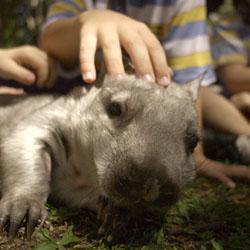Baby wombat dies
Published on 24 January, 2003
Lulu, the young southern hairy-nosed wombat that was being hand-raised for the Wombat Research Centre, has succumbed to a bone problem this week.
“Lulu was being hand-raised using techniques developed by experts in South Australia. In the last few months we had noticed that Lulu was not walking correctly,” explained a saddened Dr Alan Horsup, Senior Conservation Officer, Queensland Parks and Wildlife Service.
 Lulu was expected to have become a participant in the Wombat Research Centre’s breeding program, which is being developed to help the northern hairy-nosed wombat, one of the world’s most endangered mammals. Only 110 survive on one small national park in Central Queensland.
Lulu was expected to have become a participant in the Wombat Research Centre’s breeding program, which is being developed to help the northern hairy-nosed wombat, one of the world’s most endangered mammals. Only 110 survive on one small national park in Central Queensland.
“X-rays suggest that Lulu’s long bones had not formed correctly. She had become increasingly incapacitated and the only option was to put her down,” Dr Horsup said.
It is not yet known what caused the abnormality. An autopsy will be performed on Lulu to determine the cause.
Lulu, introduced to the community by Central Queensland University last year, was hand-reared by the staff of the Wombat Research Centre. All of the people involved in raising her are devastated, according to Dr Horsup.
“Her loss has not been in vain... We’ve learned a lot about hand-raising very small wombats which is extremely important and valuable as we continue our research program,” said Dr Horsup.
The Wombat Research Centre is a joint initiative between the Rockhampton City Council, Central Queensland Fertility, Queensland Parks and Wildlife Service and Central Queensland University.
The Centre was established at Rockhampton Zoo in 2001 to develop husbandry and reproductive techniques on southern hairy-nosed wombats. These methods will be used to assist the recovery of the critically endangered northern hairy-nosed wombat.

